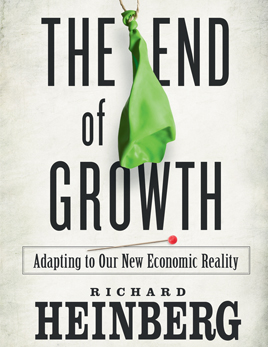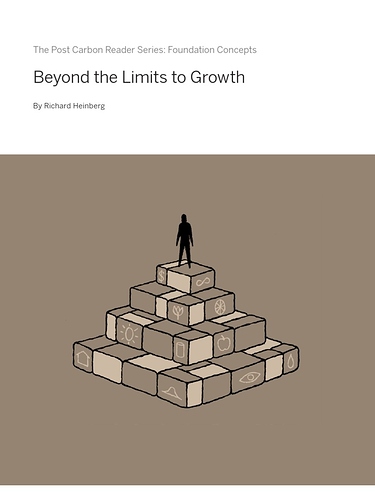Raymond Puzio wrote this:
I hope that, in retrospect, the worldwide outbreak of corona virus
will come to be regarded as a key moment which hastened the transition
from industrial-era automotive transportation to an information-era
internet of things. Further, I hope that the changes it could help
bring about would address the issues of climate change and peak fossil
fuels at a sufficient level to avert the worst level of worldwide
disaster which could even lead to general systems collapse.
An important side effect of staying at home to check the spread
disease has been to demonstrate that it is now possible to carry out a
large number of everyday tasks remotely. Some of these such as
telecommuting, online shopping, and online learning have already been
happening for quite some time, but on a smaller scale.[1] Other
activities, such as court proceedings, seminars, and conferences have
successfully transitioned to a remote format now that the in-person
versions are no longer feasible. [2,3] This provides a preview of an
alternative reality which otherwise might have required more time to
manifest itself.
It has been noted that this new way of doing things has already had
noticeable environmental effects [4,5,6]. While it is certainly
possible that things will revert to the status ante quo once the
health emergency ends, maybe continuing this trend of transitioning
in-person activities to remote counterparts could help prepare for
upcoming environmental challenges. To assess how much of an effect
this might have, let us make some rough estimates.
We begin by noting that 45% of petroleum goes into gasoline,[7] 92% of
which is used to fuel light-duty vehicles.[8] Of the total
person-distance travelled in personal cars, 18% is for commuting to
and from work, 4% is for work-related business, 12% is for shopping,
6.5% is for school and church.[9, table 5a]
Next, we turn to the Bureau of Labor Statistics’ tally of employed
persons by occupation.[10] As a rough estimate, let us suppose that
all of the jobs under the top level headings “Management,
professional, and related occupations” and “Sales and office
occupations” can be carried out remotely but that the jobs in the
remaining headings “Service occupations” “Natural resources,
construction, and maintenance occupations” “Production,
transportation, and material moving occupations” still need be carried
out on site in person. That accounts for 60% of all jobs. Also note
that most of commuting in the U.S. is done by personal car.[11]
So if, say, half the workforce telecommute and most students study
online, that would lead to a decrease in total personal car use of
about 15%. Combining this with the figure cited above, this
translates into a 7% drop in petroleum usage. (Since some of the
light-duty vehicles are commercial or governmental (e.g. police car)
so one might need to lower this figure. I haven’t located the
statistics for this one yet, but guesstimate something like 5%.)
While not enough by itself to avert environmental problems, this is
more than a negligible amount and, moreover, once a change to a new
way of doing things has begun, it could lead to further effects which
feed back in to the process and move the transition further along.
When a car is no longer needed to go to work, shop, or ferry kids to
school, many people, especially those living in urban and suburban
settings, may choose not to have cars. The purchase and upkeep of a
car costs $8500/year on average,[12] so can use up a sizable portion
of a moderate income. Automobiles and education are two major sources
of debt for many people (each accounts for 10% of total consumer
debt[13]), so that is already a major incentive to seek replacements.
For some people, the current health crisis could also help bring this
change about by disrupting habits.[14]
When more people telecommute, there will be less demand for
infrastructure such as roads, parking lots and office buildings. As a
result, it could be scaled back to make space available for alternative
uses.[15] For instance, urban space taken up by parking lots and
office buildings could turn into third space or green space. Since it
costs $28000 a year to maintain a mile of highway,[16,17] it is
impractical to maintain parts of the highway system which are
consistently underutilized.
One such alternative use which has a “back to the future but with a
twist” feel is grid-connected electric vehicles.[18] Familiar examples
include trolleys and subways which are powered by electricity taken
directly from the power grid. Newer, less familiar examples include
trucks with trolley assist[19] and personal rapid transport[20]. The
latter consists of car-size autonomous vehicles which move on suitable
guideways. These combine the energy efficiency of grid-connected
vehicles[21] with the “go any where at any time” convenience of
personal cars. Thus, there is the potential for this technology to
take over the remaining uses of cars, make an impact on jobs in the
transportation sector, and save fuel which is currently used in buses
and taxis.
One of the weak points of e-commerce as it now stands is that it
relies on existing transportation modes based upon trucks and drivers,
airplanes and pilots, to deliver the goods to the customer. Hence,
shipping costs can be a large part of the total cost for small orders
and, for any size of order, there is a choice between waiting several
days for the order to come in or paying dearly for overnight delivery.
Here too, grid-connected vehicles could also come to the rescue.
Moreover, these could be “smart” self-driving vehicles connected to
the internet as well as the electrical grid. Combined with, say,
industrial robots to move packages between trains and drones and robot
vehicles to deliver and pick up packages to and from their end
destinations,[22] this could turn into an “internet of things” which
is competitive with, say, driving downtown to pick up a few items and
so become a viable replacement for automobiles in most situations.
When this situation or something like it happens, it would have an
impact upon the material moving jobs, affect how other sectors of the
economy operate and also decrease the amount of petroleum used for
shipping and transporting goods.
- Harley Frazis, “Who Telecommutes? Where is the Time Saved Spent?” BLS
WORKING PAPERS, U. S. Bureau of Labor Statistics
https://www.bls.gov/osmr/research-papers/2020/pdf/ec200050.pdf - Nina Totenberg, “Supreme Court Arguments Resume — But With A Twist”
NPR Morning Edition
https://www.npr.org/2020/05/04/847785015/supreme-court-arguments-resume-but-with-a-twist - Suzette Parmley, “NJ Municipal Courts Back in (Remote) Session,
Judiciary Says”, New Jersey Law Journal
https://www.law.com/njlawjournal/2020/05/11/nj-municipal-courts-back-in-remote-session-judiciary-says/?slreturn=20200510101007 - Matt McGrath, “Climate change and coronavirus: Five charts about
the biggest carbon crash”, BBC News
https://www.bbc.com/news/science-environment-52485712 - Fiona Harvey, “Atmospheric CO2 levels rise sharply despite Covid-19
lockdowns”
https://www.theguardian.com/environment/2020/jun/04/atmospheric-co2-levels-rise-sharply-despite-covid-19-lockdowns - Jonathan Watts, “Blue-sky thinking: how cities can keep air clean
after coronavirus”
https://www.theguardian.com/environment/2020/jun/07/blue-sky-thinking-how-cities-can-keep-air-clean-after-coronavirus - U.S. Energy Information Administration, “Oil and petroleum products
explained”
https://www.eia.gov/energyexplained/oil-and-petroleum-products/use-of-oil.php
8.U.S. Energy Information Administration, “Gasoline explained”
https://www.eia.gov/energyexplained/gasoline/use-of-gasoline.php
- U.S. Department of Transportation, “2017 National Household Travel
Survey”
https://nhts.ornl.gov/assets/2017_nhts_summary_travel_trends.pdf - U. S. Bureau of Labor Statistics, "HOUSEHOLD DATA ANNUAL AVERAGES
- Employed persons by occupation, sex, and age"
https://www.bls.gov/cps/cpsaat09.htm - BRIAN MCKENZIE, “Who Drives to Work? Commuting by Automobile in the
United States: 2013” REPORT NUMBER ACS-32, U. S. CENSUS BUREAU
https://www.census.gov/library/publications/2015/acs/acs-32.html# - AAA “AAA REVEALS TRUE COST OF VEHICLE OWNERSHIP”
https://newsroom.aaa.com/tag/cost-to-own-a-vehicle/ - Stefan Lembo Stolba “Debt Reaches New Highs in 2019, but Credit
Scores Stay Strong”
https://www.experian.com/blogs/ask-experian/research/consumer-debt-study/ - Érika Martins, Silva Ramosa, Cecilia Jakobsson Bergstad, Jonas
Nässén, “Understanding daily car use: Driving habits, motives,
attitudes, and norms across trip purposes”
https://www.sciencedirect.com/science/article/pii/S1369847819302165 - Deborah Popper and Frank Popper, “Smart Decline in Post-Carbon
Cities”, The Post Carbon Reader Series
https://www.scribd.com/document/63670221/CITIES-Smart-Decline-by-Deborah-Popper-and-Frank-Popper - Frank Elswick “How Much Does It Cost to Maintain a Mile of Road?”
https://blog.midwestind.com/much-cost-maintain-mile-road/ - M. Gregory Fields and Spence Purnell “23rd Annual Highway Report on the
Performance of State Highway Systems”
https://reason.org/wp-content/uploads/2018/01/23rd_annual_highway_report.pdf - Richard Gilbert and Anthony Perl, “Transportation in the Post-Carbon
World”, The Post Carbon Reader Series
https://www.scribd.com/document/63609779/TRANSPORTATION-Transportation-in-the-Post-Carbon-World-by-Richard-Gilbert-and-Anthony-Perl - Hutnyak Consulting “1970-1977 - Quebec Cartier Mine, Canada”
http://hutnyak.com/Trolley/trolleyhistory.html#QCM - Railway Technology “Personal Rapid Transport”
https://www.railway-technology.com/projects/personal-rapid-transit/ - Eva Gustaffson, “Energy Efficiency of Personal Rapid Transport”
https://www.eceee.org/static/media/uploads/site-2/library/conference_proceedings/eceee_Summer_Studies/1995/Panel_6/p6_1/paper.pdf - Sarah Wray, “Robot deliveries roll out in Milton Keynes’ centre”
https://www.smartcitiesworld.net/news/news/robot-deliveries-roll-out-in-milton-keynes-centre-5117
Richard Heinberg, “The End of Growth”

The End of Growth - Richard Heinberg
The End of Growth: Adapting to Our New Economic Reality (August 2011) Economists insist that recovery is at hand. Yet, unemployment remains high, real estate values continue to sink, and governments stagger under record deficits. The End of Growth…
Richard Heinberg, “Beyond the Limits to Growth”, The Post Carbon Reader Series

BEYOND THE LIMITS TO GROWTH - Richard Heinberg | Economic Growth | Economics…
The underlying premise of the classic book The Limits to Growth is irrefutable: At some point in time, humanity’s ever-increasing resource consumption will meet the very real limits of a planet with finite natural resources. We, the authors of The…
